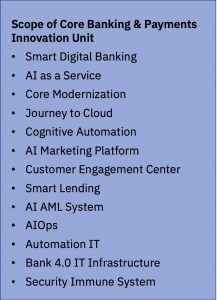Banking
Architecting Banking 4.0 with IBM’s New Innovation Unit
August 14, 2020 | Written by: David Chow
Categorized: Banking | Digital Reinvention | Digital Transformation | Services
Share this post:

Banks throughout the world is consistently ranked at the top as one of the most trusted institutions. They want their banks to offer a safe foundation for their financial planning. And banks made it their priority.
The health pandemic changed this concept of trust. We have seen significant up take on digital access to banking services and by customer segments that previously been viewed as digitally unreachable. Customers wanted their banks to be closer to them digitally as they shift to digital living. This made digital transformation an immediate business imperative for banks.
Banks are no strangers to getting close to customers. They built their market capitalization by investing in branches and regional offices to support their customer base better. Many also bolstered their digital offerings and collaborated with fintechs to improve digital convenience.
The difference now is that banks need to become digitally visible, not just be digitally available. Looking at digital as another channel is no longer enough; banks need to embrace digital as its foundation. It is what we call Banking 4.0 — banking everywhere but never only at a bank.
The business case for a new IBM Innovation Unit
Digitalization of banks is easy to state on paper, but the practical challenges are enormous. As the largest provider of technology solutions to the industry with US$64 trillion of total bank assets supported by IBM infrastructure, we know this intimately.
It is why we have brought industry and subject matter experts under a single organization called Core Banking & Payments Innovation Unit (IU). By combining the multi-functional experience and lessons in architecting systems solutions that 97% of the largest banks rely on, the new IU offers a single destination for banks to create their digital blueprint.

Take for example JETCO’s APIX — Hong Kong’s first cross-banks, cross-sectors open API exchange platform created in collaboration with IBM. By connecting banks to third-party service providers, the platform allows services providers build innovative services with the banks’ APIs.
Hang Seng Bank has been on the journey to enhance the digital experience with IBM AI technology Watson Assistant for retail customers since 2018. The award winning H A R O virtual assistant enables customers to do banking transactions through conversation. It is extended to the WhatsApp channel to make banking easier for their customers.
State Bank of India (SBI), the country’s largest bank, worked with IBM Services to launch YONO (You Only Need One). The secure mobile banking platform transformed how over 18 million people bank, invest, shop, order food and more.
While these transformations had different goals — for JETCO, it was helping Hong Kong banks and service providers to drive innovations; for SBI, it was financial inclusivity — they needed both cross-industry and cross-functional thinking.
This is the fundamental promise of the new IU. By putting our global expertise and solutions at the fingertips of Hong Kong banks’ decision makers, we want to ignite co-creation.
Why we need co-creation
In today’s connected economy, no bank is an island. Navigating the various digital-led technology options, addressing local market challenges and exploring new digital models needs both inside-out and outside-in transformational thinking.
Co-creation will also be vital for Hong Kong banks looking to seize the opportunities that the Greater Bay Area (GBA) initiative promises. As GBA gathers pace, banks need strong cross-border experience, cross-functional and cross-industry innovation.
There will be an increase in cross-border insurance and banking activities because of GBA. This will include mutual fund investments and commodities trading as highlighted in the recent Chinese government blueprint. With Hong Kong viewed as “the adapter that converts the mainland’s financial and legal voltage into the one used by the rest of the world,” the city is poised to play a key role as a global conduit.
The city’s banks will need to be ready to play a bigger role in the GBA initiative. This is where the Core Banking & Payments Innovation Unit aims to play a key role. We will integrate a number of industry efforts such as the Collaborative Innovation Program that we initiated last year into this unit.
Evolving customer trust
For certain, the future of banking lies with digital. But as the pandemic shift customer trust, banks need to get digital now.
Done correctly, the rewards and possibilities can be wide. Studies already show that relationships between banks and customers will become deeper and more interactive.
But how can banks fast track their digital transformation without eroding customer trust or their value proposition? It is a mission that the new Core Banking & Payments Innovation Unit is looking to solve through co-creation with our banking clients.

General Manager and Partner, Global Business Services, IBM Hong Kong
Why the Future of Financial Services Lie in Extreme Digitization
Three years into a global COVID-19 pandemic and financial services firms are beginning to face a different market landscape. The biggest change is customer expectations. After shifting to a more digital lifestyle, retail and business customers want the same level of seamless experience that fintechs, virtual banks, platform players, and SaaS applications offer. It’s […]
科技工具非萬能 智能工作流如何為嶄新商業模式領航?
(文章於2021年8月28日在香港經濟日報網站刊登) 新冠肺炎疫情衝擊全球經濟,逼使各行各業加快數碼轉型(Digital Transformation)及嶄新商業模式,各種創新科技也因此加速普及。個別科技工具或許能助企業暫時減輕負擔或紓解燃眉之急,但它們並不是萬靈丹。 舉個例,企業可以運用人工智能分析產品銷售的狀況並藉此作出改善建議;但要真正收效,企業就必須根據這些分析和建議,持續地改革產品研發、製造以至物流等環節。要真正發揮創新科技的效力,智能工作流(Intelligent Workflow)的革新才是關鍵。
混合雲應用增 機密運算、量子安全加密、完全同態加密增企業信心
(文章於2021年3月31日在香港經濟日報網站刊登) 有云「牛轉乾坤」,儘管今年的前景對企業而言或未明朗,但我們還是能作出一些技術相關的預測。 首先,即使是敏感和嚴格監管的行業也將繼續向混合雲轉移,但企業在過程中,需要採用多方面措施,應對安全威脅的不斷演變。而機密運算(Confidential Computing)、量子安全加密、完全同態加密(FHE,Fully Homomorphic Encryption)等安全技術將有助鞏固企業的信心。


